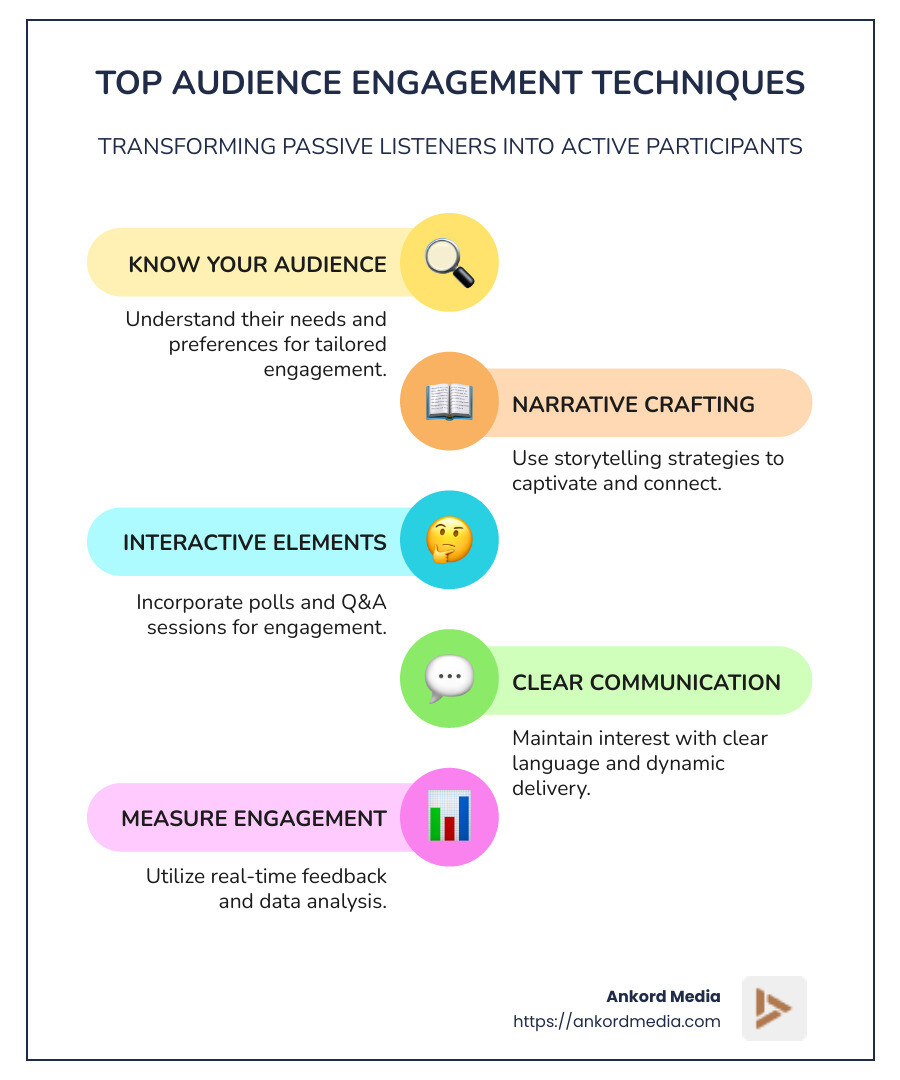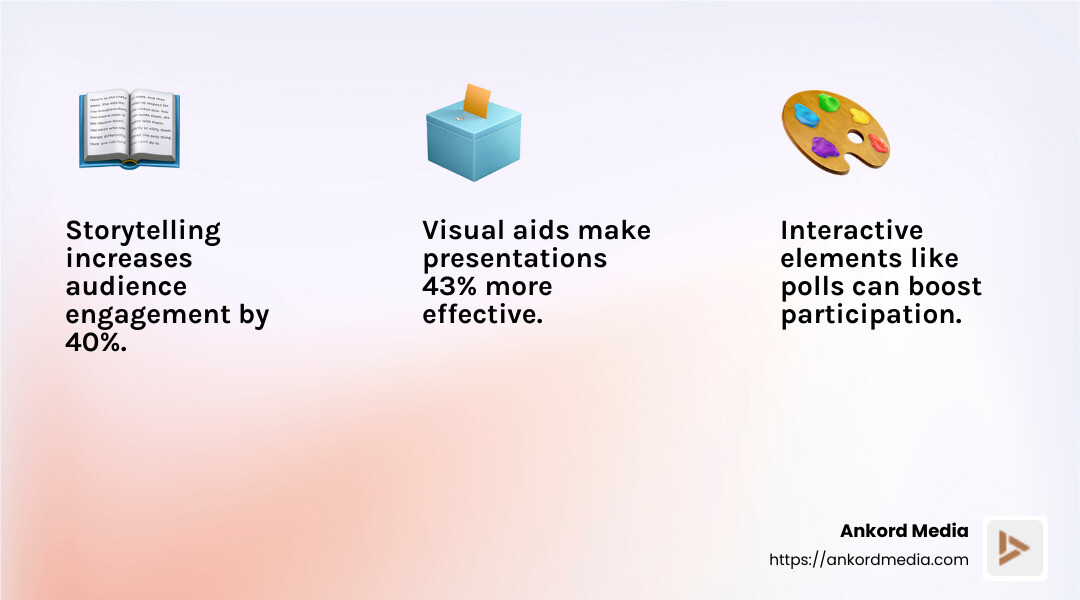Engage Like a Pro: Top Techniques for Audience Interaction

Audience engagement techniques are essential for captivating attention, sparking interaction, and building meaningful connections with your audience. Whether you're hosting a live event, launching a digital campaign, or presenting a cutting-edge idea, these techniques can transform passive listeners into active participants. Here's a quick rundown of effective audience engagement techniques:
- Understand your audience's needs and preferences.
- Craft a compelling narrative using storytelling strategies.
- Incorporate interactive elements like polls or Q&A sessions.
- Use clear language and dynamic delivery to maintain interest.
- Measure engagement with real-time feedback and data analysis.
My name is Milan Kordestani, and as a seasoned entrepreneur and the founder of Ankord Media, I've been at the forefront of leveraging audience engagement techniques to amplify brand narratives and foster digital interactions that resonate. The subtleties of these techniques have been integral to the strategic guidance we offer, ensuring our clients' visions are vividly realized.

Understanding Audience Engagement Techniques
To truly engage an audience, you need to understand what makes them tick. This means knowing what they care about, what interests them, and how they prefer to interact. Audience engagement techniques are all about creating a connection that feels personal and relevant. Here's how you can achieve that:
Audience Focus
Understanding your audience is the first step to successful engagement. You need to know who they are, what they need, and what they expect from your event or presentation.
- Research and Analyze: Use tools to track attendee behavior and preferences. This might involve analyzing which topics generate the most interest or which formats are most engaging.
- Personalize Your Approach: Tailor your content to match the audience's knowledge level and interests. This could mean defining unfamiliar terms or using examples that resonate with their experiences.
Engagement Strategies
Once you understand your audience, it's time to develop strategies that will keep them engaged.
- Storytelling: People love stories. They are a powerful tool for making your content relatable and memorable. Share personal experiences or real-life examples to illustrate your points.

- Interactive Elements: Incorporate polls, quizzes, or Q&A sessions to encourage participation. This not only keeps the audience engaged but also makes them feel like they are part of the conversation.
- Visual Aids: Use graphics, videos, or slides to break up text and provide visual interest. This can help in explaining complex ideas in a simpler way.
Interaction
Interaction is the key to maintaining audience engagement. It transforms a passive experience into an active dialogue.
- Ask Questions: Pose questions to the audience to provoke thought and encourage participation. This can be as simple as asking for opinions or feedback.
- Encourage Discussion: Create opportunities for the audience to discuss topics among themselves. This can be done through breakout sessions or group activities.
- Feedback Loops: Use real-time feedback to adjust your presentation on the fly. This can be done through live polling or audience response systems.
By focusing on your audience, employing strategic engagement techniques, and fostering interaction, you can create an environment where your audience feels connected and involved. This approach not only improves the experience but also ensures your message is heard and remembered.
Next, we'll dive into the top techniques for audience interaction, exploring physical, mental, and linguistic methods to keep your audience engaged and attentive.
Top Techniques for Audience Interaction
To truly captivate your audience, you need to employ a combination of physical, mental, and linguistic techniques. These methods work together to create a dynamic and engaging experience that keeps your audience focused and involved.
Physical Techniques
Eye Contact: Making eye contact is crucial for building a connection with your audience. It shows confidence and helps establish trust. When you look at people directly, they feel acknowledged and are more likely to pay attention.
Body Language: Your posture and movements can say a lot. Stand tall, use open gestures, and avoid crossing your arms. Positive body language can make you appear more approachable and engaging.
Gestures: Use your hands to emphasize points and add energy to your presentation. Gestures can help illustrate your message and make it more memorable. But remember, keep them natural and not too distracting.
Mental Techniques
Storytelling: Stories are powerful. They make information more relatable and easier to remember. Share a personal anecdote or a relevant case study to draw your audience in and make your message stick.
Analogies: Analogies help explain complex ideas by relating them to something familiar. For example, if you're explaining a new technology, compare it to something your audience already understands. This makes your content more accessible.
Questions: Asking questions is a great way to engage your audience mentally. It encourages them to think and participate. Use rhetorical questions to provoke thought or direct questions to invite interaction.
Linguistic Techniques
Clear Language: Avoid jargon and complex terms. Use simple, clear language that your audience can easily understand. This ensures that your message is not lost in translation.
Signposts: These are verbal cues that guide your audience through your presentation. Phrases like "firstly," "on the other hand," or "in conclusion" help listeners follow your train of thought.
Transitions: Smooth transitions between topics keep your presentation flowing. They help connect different ideas and maintain the audience's attention. Use phrases like "building on that point" or "let's move to the next topic" to create a seamless experience.
By integrating these audience engagement techniques into your presentation, you can transform a passive audience into active participants. This approach not only improves their experience but also ensures your message is effectively communicated and remembered.
Next, we'll explore how to measure audience engagement, using metrics and feedback to refine your interaction strategies.
Measuring Audience Engagement
Once you've implemented your audience engagement techniques, it's crucial to measure their effectiveness. This helps you understand what works and what needs improvement. Let's explore the key ways to measure engagement: metrics, live participation, and feedback.
Metrics
To get a clear picture of audience engagement, track specific metrics. These numbers provide valuable insights into how well your audience is connecting with your content. Here are some metrics to consider:
- Likes, Comments, and Shares: These are basic indicators of how your audience is interacting with your content on social media. A high number of likes or shares usually means your content resonates with your audience.
- Video Views and Completion Rate: If you're using video content, monitor how many people are watching and how many finish watching. A high completion rate suggests that your content is engaging throughout.
- Click-through Rate (CTR): This metric shows how effectively your content drives action. A high CTR indicates that your audience finds your content compelling enough to explore further.
- Time on Page: This tells you how long visitors are spending on your content. More time usually means more interest and engagement.
Live Participation
During events, whether in-person or virtual, live participation is a real-time measure of engagement. Here are some ways to gauge it:
- Polling and Q&A: Use live polls and question-and-answer sessions to involve your audience directly. This not only engages them but also provides instant feedback on their interests and understanding.
- Audience Retention: Track how many people stay for the entire event. A sudden drop-off can signal that something isn't working, while consistent attendance indicates sustained interest.
- Interactive Sessions: Monitor participation levels in interactive sessions or activities. High participation suggests that attendees are actively engaged.
Feedback
Feedback is invaluable for understanding audience reactions and preferences. Here's how to collect it:
- Surveys and Reviews: Send out post-event surveys to gather opinions on what worked and what didn't. Ask specific questions about different aspects of the event to get detailed insights.
- Ratings: Ask attendees to rate various sessions or speakers. This helps identify which parts of your event were most engaging.
- Direct Comments: Encourage attendees to leave comments or suggestions. This qualitative feedback can offer new perspectives and ideas for improvement.
By measuring these aspects of audience engagement, you can refine your strategies and improve future interactions. The goal is to keep your audience not just interested, but actively participating and invested in your content.
Next, we'll tackle some frequently asked questions about audience engagement techniques, offering practical solutions and examples to boost your engagement efforts.
Frequently Asked Questions about Audience Engagement Techniques
What strategies will you use to engage your audience?
Engaging your audience requires a mix of interactive elements, feedback, and active listening. Let's break these down:
- Interactive Elements: Incorporate polls, quizzes, and surveys into your events or presentations. These tools not only capture attention but also provide a platform for your audience to express their thoughts. For instance, using a live poll during a webinar can boost participation and make attendees feel involved.
- Feedback: Actively seek feedback during and after your events. This can be done through real-time Q&A sessions or post-event surveys. Feedback helps you understand what resonated with your audience and where improvements are needed.
- Active Listening: Show your audience that you value their input by responding to comments and questions promptly. This two-way communication fosters a sense of connection and encourages more interaction.
How do you measure audience engagement?
To effectively measure audience engagement, focus on both quantitative and qualitative metrics:
- Time on Page: This metric indicates how long users spend on your content, reflecting their interest level. Longer durations suggest higher engagement.
- Comments and Social Shares: Track the number of comments and shares your content receives. These interactions signal that your audience finds your content relevant and worth discussing or sharing with others.
- Polls and Quizzes: Analyze the participation rates in polls or quizzes. High engagement in these activities can indicate that your content is resonating well with your audience.
What is an example of audience engagement?
A tangible example of audience engagement is using polls during a webinar. For instance, you might ask attendees to vote on a topic they want to explore further. This not only involves them in the decision-making process but also provides insights into their interests.
Another example is conducting quizzes related to your presentation's content. This encourages participants to pay close attention and reinforces key points. Plus, it adds a fun, interactive element to your event.
Incorporating these audience engagement techniques can transform a passive audience into active participants, enhancing the overall experience and ensuring your message is both heard and valued.
Conclusion
At Ankord Media, we believe that storytelling is at the heart of effective audience engagement. It's not just about conveying information; it's about creating an emotional connection that resonates with your audience. This is where our expertise in crafting authentic narratives and impactful digital experiences comes into play.
Customer connections are crucial in today's digital world. By focusing on building genuine relationships, we help our clients transform their bold ideas into tangible success. Our approach combines strategic branding, cutting-edge design, and the latest technology to ensure that every interaction is meaningful and memorable.
To truly engage like a pro, understand your audience's needs and preferences. By leveraging audience engagement techniques such as interactive elements, clear communication, and active listening, you can foster a community that is not only engaged but also loyal.
If you're ready to lift your brand and create impactful customer connections, let us help you tell your story in a way that captivates and converts. Find more about our services and how we can partner with you to achieve your vision at Ankord Media.

